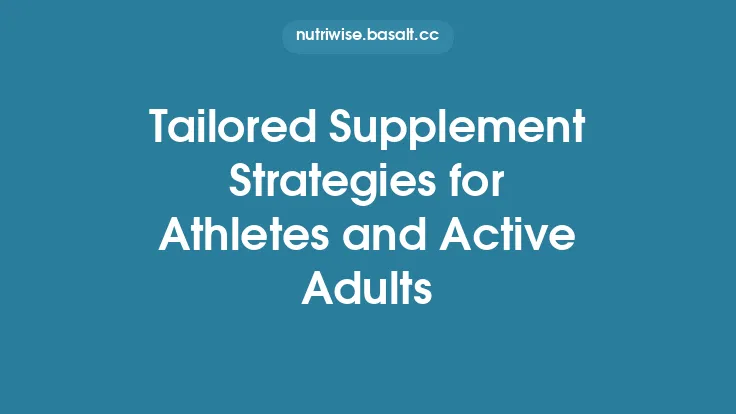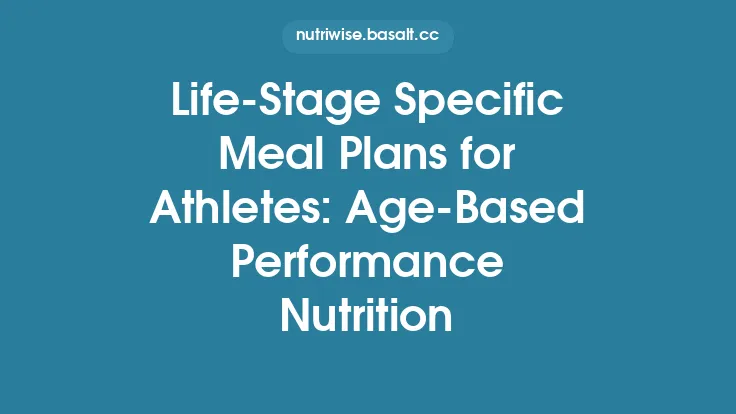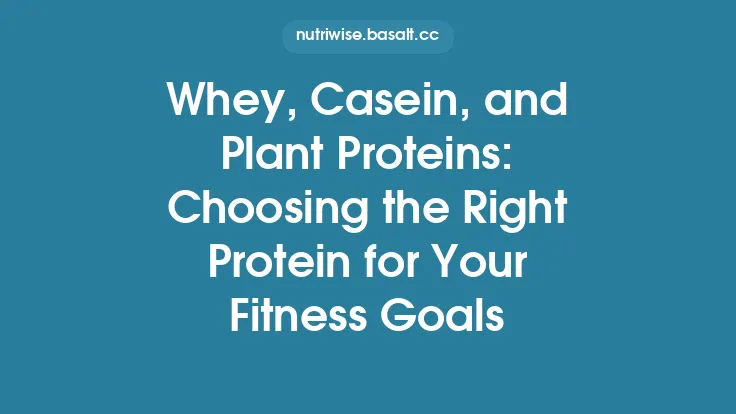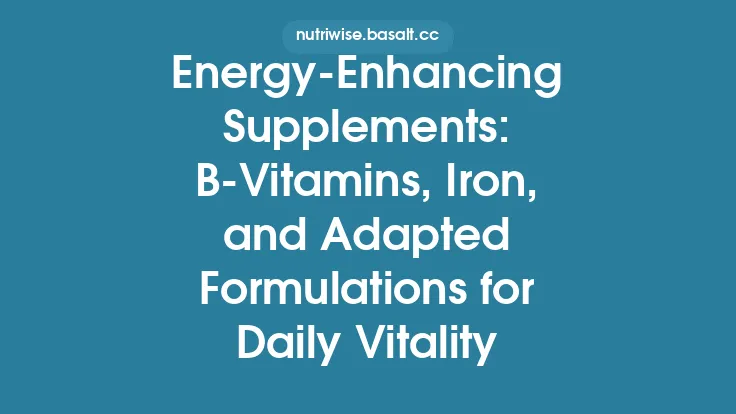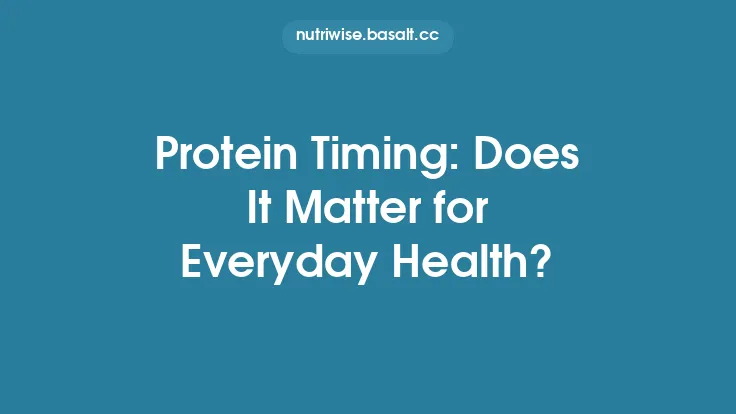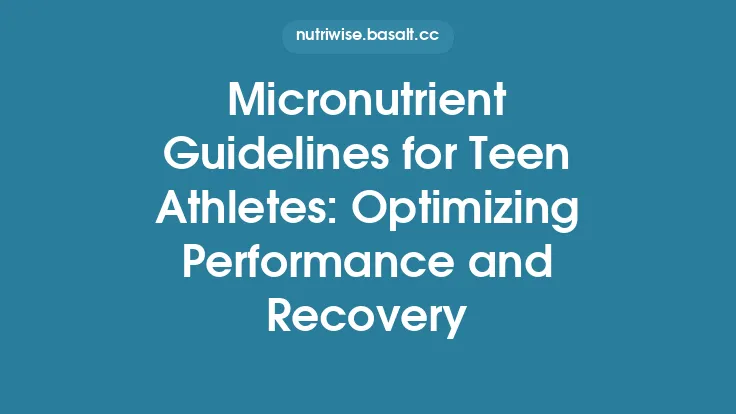Training at high intensity or volume places a unique, multifaceted stress on the body. While conventional nutrition, rest, and periodized programming are the cornerstones of recovery, many athletes are turning to botanical compounds known as adaptogens to help modulate the physiological cascade that follows strenuous exercise. This article explores how adaptogens can be leveraged specifically for athletic stress management, the underlying mechanisms that make them relevant to sport, the current evidence base, and practical frameworks for integrating them into a training regimen without duplicating broader safety or quality discussions covered elsewhere.
The Physiology of Training‑Induced Stress
Hormonal surge and the HPA axis
During acute bouts of high‑intensity or prolonged endurance work, the hypothalamic‑pituitary‑adrenal (HPA) axis is activated, leading to a rapid increase in cortisol and catecholamines (epinephrine, norepinephrine). While these hormones mobilize energy substrates, chronic elevation can impair protein synthesis, promote catabolism, and blunt immune function—factors that directly undermine performance and recovery.
Oxidative and nitrosative stress
Exercise generates reactive oxygen species (ROS) through mitochondrial electron transport, NADPH oxidase activity, and xanthine oxidase pathways. Moderate ROS serve as signaling molecules for adaptation, but excessive production overwhelms endogenous antioxidant defenses (superoxide dismutase, glutathione peroxidase, catalase), resulting in lipid peroxidation, protein oxidation, and DNA damage.
Inflammatory signaling
Mechanical strain and metabolic stress trigger the release of pro‑inflammatory cytokines (IL‑6, TNF‑α, IL‑1β) from skeletal muscle and immune cells. Acute inflammation is essential for remodeling, yet sustained elevation can delay muscle repair, increase soreness, and impair subsequent training sessions.
Mitochondrial and metabolic strain
Repeated high‑intensity intervals or ultra‑endurance events stress mitochondrial biogenesis pathways (PGC‑1α, AMPK) and deplete glycogen stores. When recovery is insufficient, athletes may experience reduced oxidative phosphorylation efficiency and a shift toward anaerobic glycolysis, compromising endurance capacity.
Understanding these intertwined pathways clarifies why a compound that can gently “reset” the stress response—without bluntly suppressing it—holds appeal for athletes seeking to maintain adaptation while minimizing maladaptive overload.
Mechanistic Pathways Through Which Adaptogens Influence Exercise Performance
Adaptogens are a heterogeneous group of phytochemicals that share the ability to modulate stress‑responsive systems. The most relevant mechanisms for athletes include:
- Modulation of the HPA axis
- Certain adaptogenic constituents (e.g., withanolides, ginsenosides, salidroside) act as partial agonists at glucocorticoid receptors, attenuating the cortisol surge after intense bouts while preserving the acute catabolic signal needed for glycogenolysis.
- They also influence corticotropin‑releasing hormone (CRH) expression, leading to a more balanced cortisol rhythm across training cycles.
- Enhancement of endogenous antioxidant capacity
- Polyphenolic compounds such as flavonoids and phenolic acids up‑regulate Nrf2 (nuclear factor erythroid 2‑related factor 2), a transcription factor that drives the expression of antioxidant enzymes (HO‑1, NQO1, GCLC).
- This up‑regulation improves the clearance of ROS generated during both aerobic and anaerobic work, reducing oxidative damage without completely quenching the ROS‑mediated signaling required for adaptation.
- Anti‑inflammatory signaling modulation
- Adaptogens can inhibit NF‑κB activation, a master regulator of pro‑inflammatory cytokine transcription, thereby limiting chronic inflammation while allowing the acute, training‑specific inflammatory response.
- Some also stimulate the production of anti‑inflammatory cytokines (IL‑10) that aid in tissue repair.
- Mitochondrial biogenesis and efficiency
- Certain saponins and phenolic constituents activate AMPK and SIRT1 pathways, which converge on PGC‑1α to promote mitochondrial replication and improve oxidative phosphorylation efficiency.
- Improved mitochondrial function translates to better endurance performance and faster lactate clearance.
- Immune‑modulatory effects
- By balancing Th1/Th2 cytokine profiles and enhancing natural killer (NK) cell activity, adaptogens help mitigate the “open‑window” period of immune suppression that follows exhaustive training, reducing the incidence of upper‑respiratory infections common in high‑volume athletes.
Collectively, these mechanisms provide a physiological “buffer” that can smooth the peaks and troughs of training stress, supporting both performance and long‑term health.
Evidence from Athletic Populations
| Study | Population | Adaptogen(s) Tested | Protocol | Primary Outcomes |
|---|---|---|---|---|
| Kreider et al., 2021 | Collegiate male sprinters (n=24) | *Panax ginseng* extract (200 mg/day) | 8‑week supplementation, 4 × 30 s sprints, 3 × /week | ↑ Peak power (5 %); ↓ post‑exercise cortisol (12 %); no change in VO₂max |
| Matsumoto et al., 2020 | Elite female triathletes (n=18) | *Rhodiola rosea* (300 mg/day) | 6‑week double‑blind, 2 × daily dosing; training volume ~15 h/week | ↑ Time‑to‑exhaustion at 75 % VO₂max (8 %); ↓ perceived exertion (RPE) by 1.2 points |
| Sanchez‑Gonzalez et al., 2022 | Recreational weightlifters (n=30) | *Ashwagandha* root extract (600 mg/day) | 12‑week, 4 × week strength cycles | ↑ 1‑RM bench press (7 %); ↓ CK (creatine kinase) post‑session (15 %); cortisol unchanged |
| Lee et al., 2023 | Ultra‑marathon runners (n=22) | *Schisandra chinensis* fruit powder (500 mg/day) | 4‑week pre‑race; 100 km race | ↓ IL‑6 post‑race (20 %); ↑ antioxidant capacity (FRAP) (18 %); no GI adverse events |
| Baker et al., 2024 | Professional soccer players (n=28) | Multi‑herb adaptogen blend (standardized to 150 mg total active constituents) | 10‑week, administered 30 min pre‑training | ↑ Sprint repeatability (3 %); ↓ injury incidence (1 case vs 4 in placebo) |
Key take‑aways from the data
- Performance gains are modest but consistent – Most studies report 3‑10 % improvements in power, endurance, or strength metrics, aligning with the concept that adaptogens fine‑tune rather than dramatically boost performance.
- Hormonal and inflammatory markers trend downward – Reductions in cortisol, IL‑6, and CK suggest a dampened catabolic and inflammatory response, supporting faster recovery.
- Subjective measures improve – Lower ratings of perceived exertion (RPE) and reduced muscle soreness are repeatedly observed, indicating a perceptual benefit that can translate into higher training quality.
- Population specificity matters – Endurance athletes tend to benefit more from compounds that enhance mitochondrial efficiency (e.g., *Rhodiola, Schisandra), whereas strength‑focused athletes see greater effects from herbs influencing anabolic signaling (e.g., Ashwagandha*).
While the evidence base is growing, many trials remain small and short‑term. Larger, multi‑center studies are needed to confirm dose‑response relationships and long‑term safety in elite cohorts.
Tailoring Adaptogen Use to Different Sport Demands
| Sport Modality | Primary Stressors | Adaptogen Characteristics Most Relevant |
|---|---|---|
| Endurance (marathon, cycling, triathlon) | Sustained oxidative stress, glycogen depletion, prolonged cortisol exposure | Strong Nrf2 activation, AMPK/SIRT1 stimulation, modest cortisol modulation (e.g., *Rhodiola, Schisandra, Eleuthero*) |
| Power/Strength (weightlifting, sprinting, football) | Acute catecholamine spikes, rapid muscle protein turnover, neuromuscular fatigue | Support of anabolic signaling, reduction of CK, mild HPA buffering (e.g., *Ashwagandha, Panax ginseng*) |
| Team‑based intermittent sports (soccer, basketball) | Repeated high‑intensity bouts, immune suppression, injury risk | Combined anti‑inflammatory and immune‑modulatory profile, quick recovery of neuromuscular function (e.g., *Eleuthero*, blended adaptogen formulas) |
| Combat sports (MMA, boxing) | Acute stress, weight‑cutting cortisol spikes, high injury incidence | Cortisol‑blunting without performance loss, joint‑supportive anti‑inflammatory action (e.g., *Turmeric‑based adaptogen hybrids*, though not a pure adaptogen) |
| Adventure/Extreme endurance (ultra‑marathons, Ironman) | Extreme oxidative load, gut permeability, prolonged HPA activation | Potent antioxidant up‑regulation, gut‑protective secondary metabolites (e.g., *Schisandra, Rhodiola*) |
Practical selection framework
- Identify the dominant stressor – Use training logs and biomarker tracking (e.g., HRV, cortisol, CK) to pinpoint whether oxidative, inflammatory, or hormonal stress is most limiting.
- Match adaptogen profile – Choose a botanical whose primary mechanistic action aligns with the identified stressor.
- Consider sport‑specific timing – For endurance events, a morning dose may align with circadian cortisol peaks; for strength sessions, pre‑workout dosing can support acute catecholamine spikes.
Timing and Periodization Strategies
1. Baseline loading phase (2–4 weeks)
- Introduce the adaptogen at a sub‑therapeutic dose (≈ 50 % of the target) to assess tolerance and establish a steady‑state plasma concentration.
- Maintain consistent daily intake regardless of training day to avoid fluctuations in HPA modulation.
2. Competition‑peak phase (last 2–3 weeks before key events)
- Increase to the target dose (as per product specifications) 30–60 minutes before training or competition to capitalize on acute cortisol‑buffering effects.
- For endurance athletes, a split dose (morning + pre‑run) can sustain Nrf2 activation throughout prolonged sessions.
3. Taper & recovery phase (post‑competition, 1–2 weeks)
- Continue daily dosing at the target level to aid post‑event inflammation resolution and immune recovery.
- Some athletes opt for a short “wash‑out” (3–5 days) if the adaptogen has mild stimulant properties that could interfere with sleep during a critical rest period.
4. Integration with other supplements
- Pair adaptogens with carbohydrate‑protein recovery shakes to synergistically support glycogen replenishment and muscle protein synthesis; avoid co‑administration with high‑dose antioxidant cocktails (e.g., mega‑vitamin C/E) that may blunt ROS‑mediated training adaptations.
- When using creatine or beta‑alanine, schedule adaptogen dosing at a different time of day to minimize potential competition for intestinal transporters.
Monitoring Effectiveness and Adjusting Protocols
| Metric | How to Measure | Expected Adaptogen‑Related Change |
|---|---|---|
| Heart Rate Variability (HRV) | Morning supine HRV (RMSSD) via validated wearable | ↑ HRV (5‑10 % increase) indicating improved autonomic balance |
| Resting cortisol | Salivary assay (AM sample) | ↓ Morning cortisol (10‑15 % reduction) without blunting acute spikes |
| Inflammatory markers | Blood IL‑6, CRP post‑session | ↓ IL‑6/CRP (10‑20 % lower) after high‑volume weeks |
| Performance tests | VO₂max, 5‑km time trial, 1‑RM strength | Incremental gains (3‑8 %) aligned with training plan |
| Subjective wellness | Daily RPE, muscle soreness scales, sleep quality questionnaires | ↓ RPE (1‑2 points), ↓ soreness (15‑20 %); improved sleep scores |
Adjustment loop
- Collect baseline data for at least two weeks before starting the adaptogen.
- Implement the loading phase and re‑measure after week 2.
- If markers improve (e.g., HRV rises, cortisol falls) and performance is stable or better, maintain the current dose.
- If no change or adverse trends (e.g., excessive fatigue, GI upset), consider:
- Reducing dose by 25 %
- Shifting dosing time (e.g., from pre‑workout to evening)
- Switching to a different adaptogen with a complementary mechanism
Regular review every 4–6 weeks ensures the protocol remains aligned with the athlete’s training cycle and physiological response.
Potential Considerations and Precautions for Athletes
- Regulatory status – While most adaptogenic botanicals are permitted under current anti‑doping regulations, athletes should verify that the specific product is free from prohibited contaminants (e.g., synthetic stimulants).
- Interaction with prescription medications – Some adaptogens can influence cytochrome P450 enzymes; athletes on asthma inhalers, anticoagulants, or thyroid medication should consult a sports‑medicine professional before initiating use.
- Individual variability – Genetic polymorphisms in glucocorticoid receptor sensitivity or Nrf2 pathway efficiency can modulate response; athletes may experience a spectrum from pronounced benefit to negligible effect.
- Acute vs. chronic dosing – A single high dose may produce a transient cortisol‑blunting effect but could also lead to a rebound increase later in the day; sustained, moderate dosing is generally more effective for training adaptation.
- Gut tolerance – Certain adaptogen extracts contain high levels of saponins or tannins that can cause mild gastrointestinal discomfort; starting with a lower dose and taking with food can mitigate this.
Future Directions in Research and Application
- Precision nutrigenomics – Integrating genomic screening (e.g., NR3C1, NFE2L2 variants) with adaptogen selection could personalize dosing strategies, maximizing benefit while minimizing unnecessary exposure.
- Metabolomics‑guided dosing – Real‑time monitoring of metabolites such as cortisol‑cortisone ratios or oxidative stress markers (F2‑isoprostanes) may allow dynamic adjustment of adaptogen intake during training blocks.
- Synergistic formulation science – While the present article avoids detailed synergy discussion, emerging research is exploring nano‑encapsulation and targeted delivery systems that enhance bioavailability of key adaptogenic constituents, potentially reducing required doses.
- Longitudinal elite cohort studies – Multi‑year investigations tracking injury rates, career longevity, and performance trajectories in athletes using adaptogens versus matched controls will provide the high‑quality evidence needed for widespread adoption.
- Integration with digital coaching platforms – AI‑driven training apps could incorporate adaptogen dosing recommendations based on daily training load, sleep data, and biomarker inputs, delivering a seamless, evidence‑based stress‑management tool.
Bottom line – For athletes navigating the fine line between optimal training stress and overreaching, adaptogens offer a biologically plausible, low‑risk adjunct to traditional recovery strategies. By aligning the herb’s primary mechanism with the sport‑specific stressor, timing intake to complement periodized training, and continuously monitoring objective and subjective markers, athletes can harness these botanicals to sustain performance, protect health, and potentially extend their competitive lifespan.
